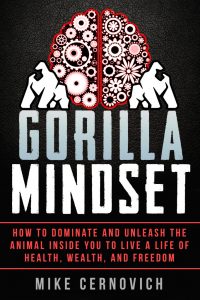In the introduction and the meta information (description, pitch, etc), Mike Cernovich promises a lot: improve your self-condfidence, stop bad moods, develop clear and sharp thinking, and so on. That sounds like a lot to change in a single mindset book, but he really delivers with some great examples. He uses both his own experience and that of others, and occasionally talks to experts (notably, in behavior and psychology). I’m not trying to hype the book as a miracle: only you can change you. But Mike details several issues surrounding the way we think, and think of and about ourselves. In a time where so many are depressed, upset, frenzied — it’s amazingly useful and approachable.
“Your mindset is a choice” — Gorilla Mindset
This simple phrase is one of the most powerful keys to life, and with it, let’s get into the book:
“If you talked to your friends like you talk to yourself, you wouldn’t have any friends.” — Mike Cernovich
The first chapter of the book covers self-talk — the way we talk about ourselves, the way our internal monologue speaks about us. I don’t want to give anything away or summarize the book too much, but Mike goes over several real-life examples of how we down-talk ourselves — and how that hurts us in the long run. This is one of my greatest faults: I love to hate on myself. Mike tries to push us away from that, and he has several exercises for getting into a more positive system of self-talk. It may be the most important chapter in the book for me to refer back to.
Following that, he segues into framing, including ways to frame events in the best way for you and your mindset. This is something a lot of us never learn — our culture tends to steal the ability to set frame, to place it in the hands of others. We aren’t really supposed to set our own frame, and we grow up learning to be put into the frame others set forth. This chapter also covers, quite succinctly, most of everything other self-improvement books will cover: turning problems into opportunities.
This, in turn, segues nicely into a discussion of mindfulness, or being in the moment. There are also exercises and methods here. This chapter may be the most interesting for a writer, if they have no other mindset issues crippling them: mindfulness is focus, paying attention, being in the moment. Mike explains several ways to improve your mindfulness and ability to focus, to notice. Each chapter builds on the last, and he builds this into the chapter on State (chapter 4), which is where mood and emotions really come into focus.
State, emotion, focus — that plays back into the first quote. A choice. You must choose to control that, just as you must choose to make any positive change in your life and behavior. This chapter has detailed steps for controlling and directing your state (emotions), and also detailed worksheets — some of the most detailed in the book. State naturally builds into focus, which is something we all seem to have trouble with now. Everything is beeping, making noise, demanding our attention. We all have constant interruptions at work — but there are ways to force focus into our lives.
As I’ll say many times, each chapter builds on the last, introducing one concept and covering it in an approachable, but complete, manner. The one concept, one chapter nature may also increase it’s appeal to me as a programmer: a function in programming should do one thing, and well. These chapters explain one big concept, and well.
After getting your mind right, your focus right, it’s time to focus on everything else around us, and our own bodies are a part of that. There are a lot of details about diet, stature/posture, exercise, and having routines. On the surface this may not seem important to mindset, but it all feeds back into the system. Your body keeps your brain going. These are mostly covered in Chapters 6, 7, and 8, including a great talk about Willpower — which is one of the biggest confirmations for me, when Mike talks about our limited Willpower and how it’s similar to a muscle. But posture, diet, exercise — all of that also plays into our life a great deal. Posture is underrated in a smartphone and keyboard age.
There are other topics in the book as well — money, and work-ethic/running a business sort of stuff. Mindset plays a great role in all of that, and Mike covers it in a great way. Again, I’m trying not to summarize too much but I want to get across just how many topics are covered, and how important they all are to one another. Each chapter builds on the last, but in many ways they could be put in other orders and make just as much sense because so much of our lives contributes to our base mindset.
Instead of going into further detail let’s summarize with the Good, the Bad, and the Ugly.
The Good
The content. The writing. Mike covers so much, in a relatively short amount of words. But it’s also easy to follow and approachable, with great examples at every turn.
If applied, the book can make your life so much different — so much better. The lack of mindset control is the downfall of so many people, and the skyrocketing number of depression cases and moodiness is evidence of that.
The Bad
Honestly, the worst part about this book is knowing that if you don’t make benefit of the advice in it, it’s your own fault.
The Ugly
The ugly is honestly how we talk about ourselves, so often. Read this book and learn not to do that anymore.

